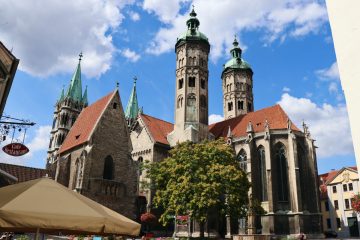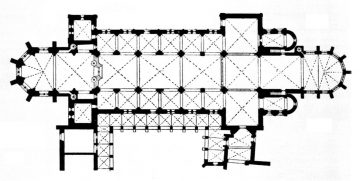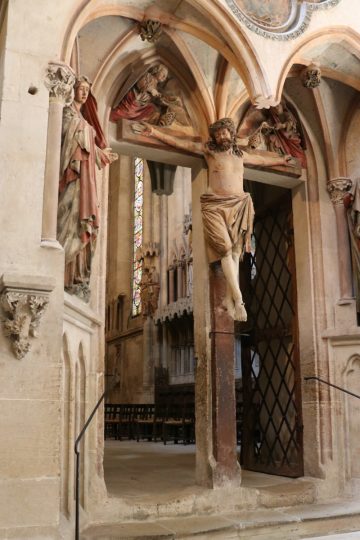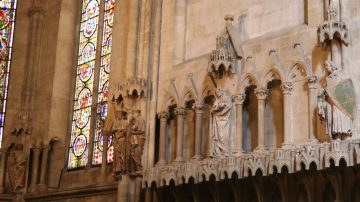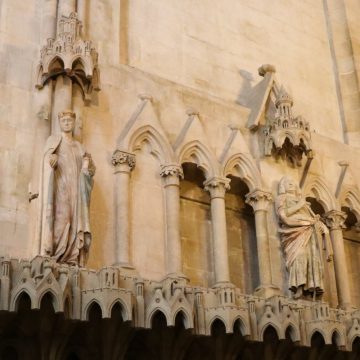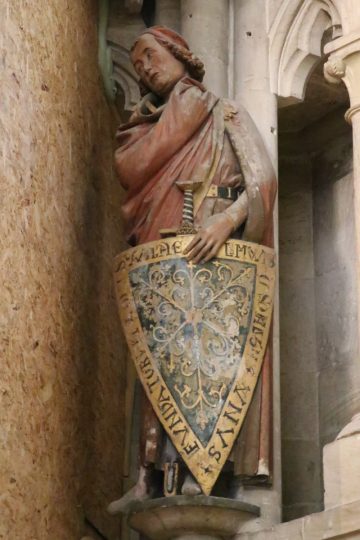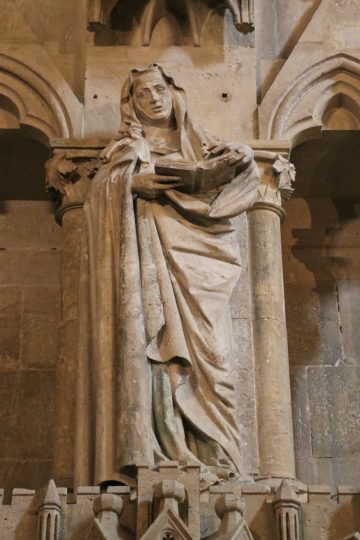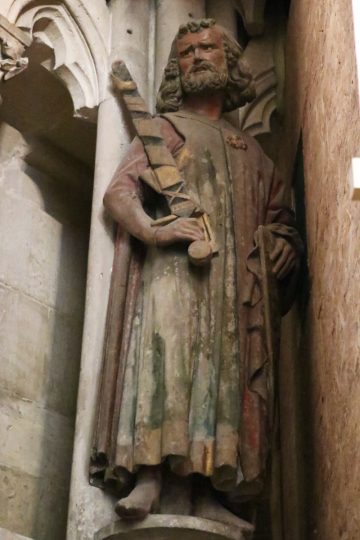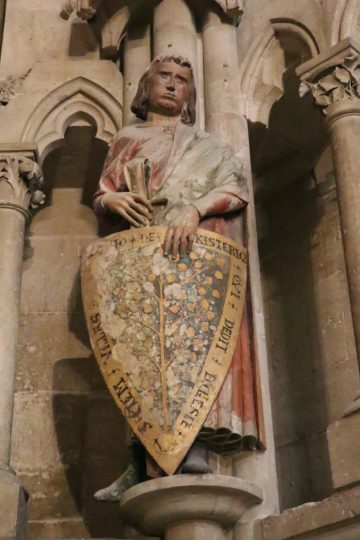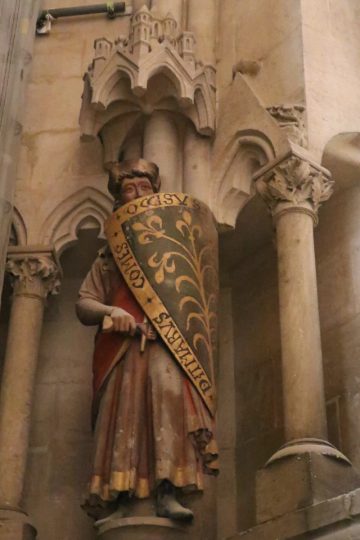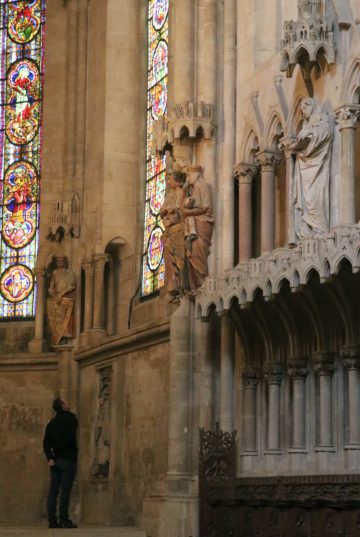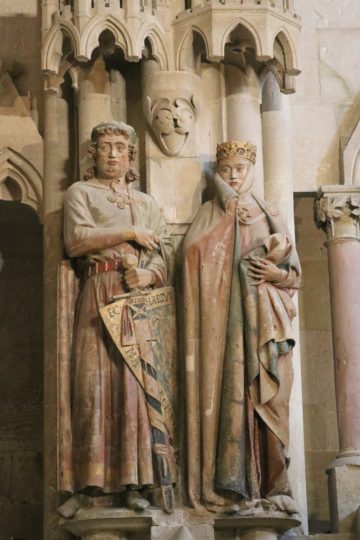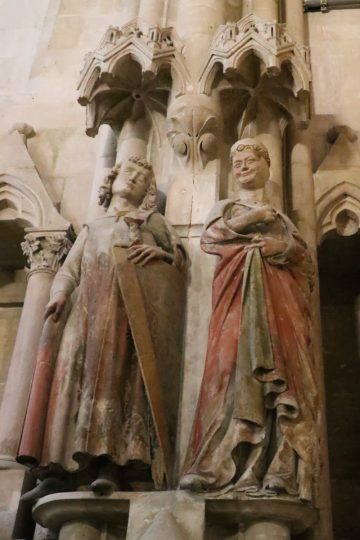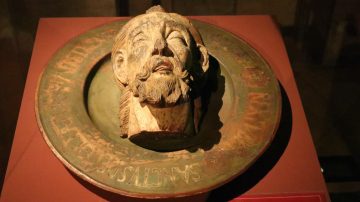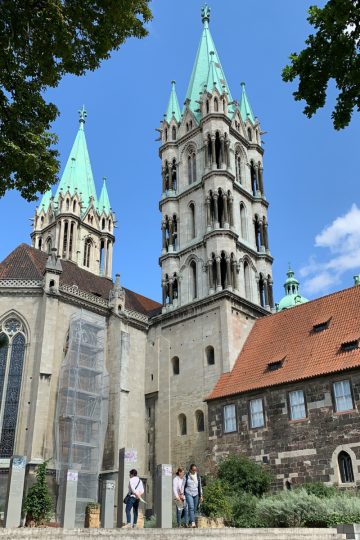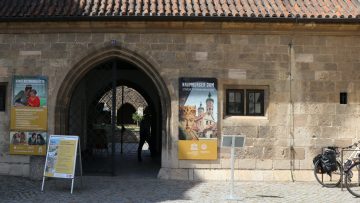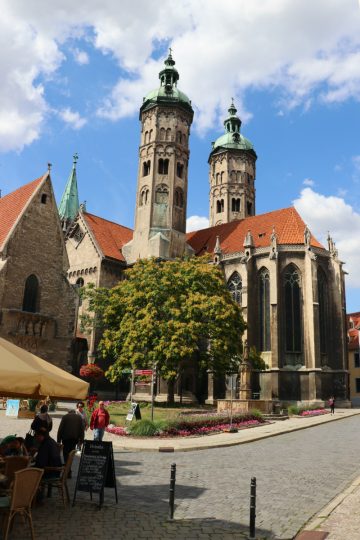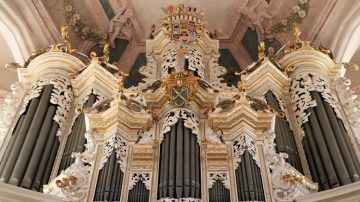Visit the Romanesque-Gothic Naumburg Cathedral (Naumburger Dom) to see the Uta sculpture and other highlights of medieval art in Germany.
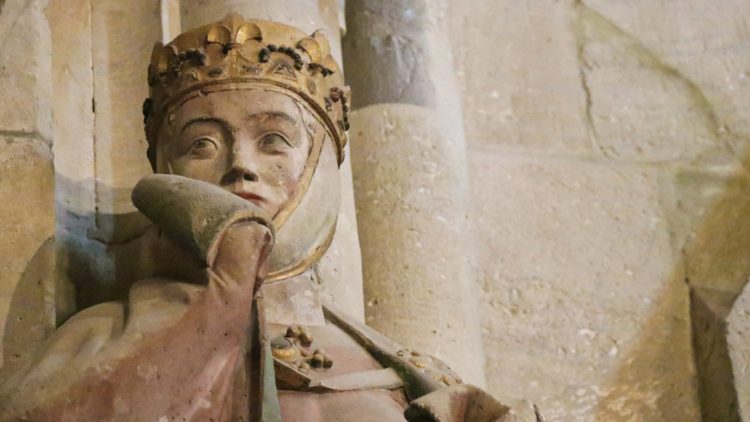
Naumburg Cathedral (Naumburger Dom St Peter und St Paul) is a Romanesque-Gothic masterpiece in the state Saxony-Anhalt in the geographical center of eastern Germany. The church is particularly famous for the architectural and sculpted masterpieces by the Master of Naumburg that are some of the most important early Gothic monuments in Germany. The 12 life-sized sculptures of the donors, especially the serene Uta von Ballenstedt, are artistic highlights of the Middle Ages and early Gothic period. Although Naumburg Cathedral was added to the UNESCO World Cultural Heritage list in 2018, the church and the rest of this pleasant town still remain fairly quiet and undiscovered by foreign tourists. Naumburg an der Saale is around half an hour by train from Halle or Leipzig.
UNESCO-Listed Naumburg Cathedral in Saxony-Anhalt
The Naumburger Dom is an outstanding example of medieval architecture and art. The Romanesque core flanked by two Gothic choirs and four bell towers demonstrated the stylistic transition from the Romanesque to early Gothic architecture that occurred in most of Germany during the 13th century.
The Gothic artworks, especially the 12 life-size statues of the cathedral donors by the Master of Naumburg and accompanying the deep-relief rood screen, are amongst the highlights of medieval art in Europe. The portrayal of Uta von Ballendstedt made her one of the icons of Gothic sculpture and often considered the most-beautiful woman in medieval Europe.
Naumburg Cathedral was inscribed on the UNESCO World Cultural Heritage list in 2018, as the 44th German UNESCO-listed site. Since then, it attracted nearly 150,000 paying visitors per year.
Romanesque-Gothic Naumburg Cathedral
The history of Naumburg Cathedral goes back to around 1029 when construction of an early Romanesque church was begun. This church was financed by amongst others the brothers Hermann (c. 980 – 1038) and Ekkehard II (c. 985 – 1045), the margraves of Meissen, who both died childless.
A crypt was added to this church around 1170 and this is the only room of the original church that survived intact when construction of the current building started in 1210. The core of this church is late-Romanesque but the west choir that was completed by 1260 is early Gothic, while the east choir added around 1330 is already high Gothic.
All four towers are part of the Romanesque structure but the western two were finished with Gothic detailing. The baroque roof and lanterns of the eastern towers were added during the early 18th century while neo-Gothic floors were added to the southwestern tower during the late 19th century. At around the same time, the Baroque interior from the mid-18th century was removed to return the church somewhat to its original medieval appearance.
High Gothic East Choir
With Gothic choirs at each end, the triple-nave Naumburger Dom is entered from the side through the main portal with a few interesting Romanesque sculptures. After entering the main church, it is possible to descend to the crypt that dates from 1160-70 and is the only room surviving from the original early Romanesque church. The wooden crucifix here is from the same period.
More interesting is ascending to the elevated east choir. The bronze handrail was made in 1972 by the Magdeburg artist Heinrich Apel — it shows a procession of animals approaching St Francis of Assisi. He added a similar railing for the stairs at the opposite side of the choir in 1983 showing the “Narrow Path” that the faithful has to climb to reach paradise — at the lower end of this railing is a snakehead with the devil right behind.
Some of the stained-glass windows are originals from the building period while others were added in the early 15th century. The altar (1510) shows the Virgin with St Katharine, St Barbara, and the twelve apostles. The 13th-century grave of Bishop Dietrich II and the life-size statue of the dean holding a Bible are from the workshop of the Master of Naumburg.
The wooden choir stalls date from around 1500. The lecterns (Lesepulte) are even older with the smaller dating from the 13th century. A copy of a medieval choral book is usually on display — originals are in the treasury and may weigh up to 45 kg each (nearly 100 pounds).
Nave of the Naumburger Dom

The nave of the Naumburg Cathedral is framed by remarkable rood screens on both the eastern and western ends. The east rood screen is the oldest complete Romanesque rood screen of this kind in Germany. It dates from 1230 and with three vaulted spaces resembles a building on its own rather than just a screen to separate the laity from the clergy. It is topped by a series of paintings of saints while the crucifix hanging down from the ceiling is from the 16th century.
The pulpit dates from 1466, and although largely restored during the 1930s, the scenes with the 12-year-old Jesus in the temple, St Augustin, and St George are considered original. A depiction of Martin Luther reminds that the first evangelical (protestant) bishop ever, Nikolaus von Amsdorf, was ordained here by Luther in person in 1542.
The chapel to the northwest of the nave has the oldest stone sculpture of St Elizabeth of Thuringia, around 1235-40. She is revered for her charity, especially to the poor and sick.
The modern organ by Eule was built in 1983 with 28 registers. The organ in Naumburg, and one of the finest in the world, is the Hildebrandt organ with input by Bach and Silbermann in the Stadtkirche St. Wenzel on the Markt in Naumburg.
West Choir of Naumburg Cathedral
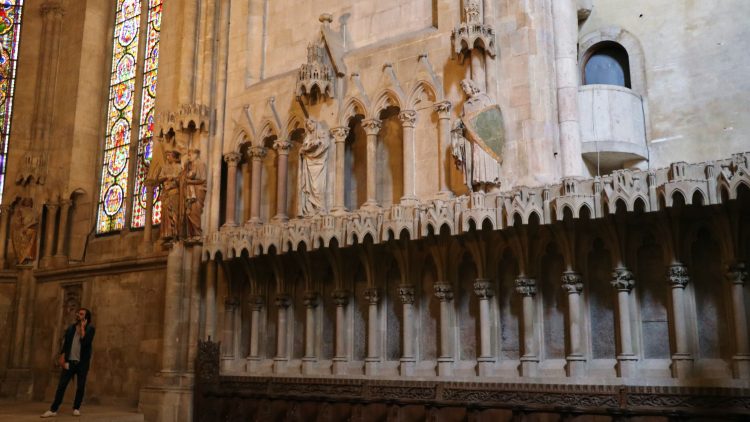
The west choir of the Naumburg Cathedral is not only the artistic highlight of the church but also considered one of the most important architectural and artistic monuments of the Middle Ages in Germany. It was made by the Master of Naumburg (Naumburger Meister), whose name is not known but whose work survived from France, where he learned his trade, to Mainz, Naumburg, and Meißen. His work in Naumburg was of such quality that it gave him his notname.
This Gesamtkunstwerk consists of the west choir itself, the rood screen that serves as a chapel facade and portal, as well as the remarkable statues of the 12 donors.
Early Gothic West Choir
Naumburg Cathedral’s west choir was constructed between 1249 and 1260. As an early Gothic work, a style at this stage fairly unknown in this part of Germany, the Master of Naumburg used classical proportions in the creation of his masterpiece.
The nearly square nave is finished with a polygon that represents the five sides of an octagon. Light enters the choir through the tall windows in the five sides of this polygon. The stained glass in three of these windows are considered largely original.
Gothic West Rood Screen

The Gothic west rood screen, made by the Master of Naumburg around 1240-50, is considered one of the most important art and architectural items from the Middle Ages. He used highly realistic portrayals of figures and exact depictions of leaves, fruit, and flowers in the decorations of the capitols and friezes. (Many of these plants — around 200 could be identified —are in the special garden of the cathedral.) Instead of the typical low reliefs for the period, the reliefs here showing the passion of Christ are carved up to 35 cm deep.
In contrast to the eastern rood screen that should divide the laity from the clergy, the western rood screen serves as a chapel facade and a portal to the western choir. To enter this choir, which could function as a completely separate church, it was necessary to pass directly underneath the outstretched arms of Christ on the Cross. This Christ is a very realistic portrayal of a normal man and the crucifix is not hung high up, as was customary, meaning Christ is suffering almost at eye level with the observer.
The reliefs depict (from left) the Last Supper, Judas receiving the 30 pieces of silver, the arrest of Christ, Peter denying knowledge of Christ, two guards, Pilate washing his hands, flagellation, and carrying of the Cross. The last two scenes in wood are from 1737 but finished in the same style to replace the scenes damaged in a major fire in 1532. Note the juxtapositioning of especially Peter and the isolated Judas at the (reduced) final supper and the typical conical hats worn by the Jews but not by the disciples or Romans.
Donor Sculptures of Naumburg Cathedral
The 12 donor sculptures (Stifterfiguren) of Naumburg Cathedral are the best-known works of early Gothic art in Germany. These life-size sculptures are very realistic and show fine details quite in contrast to the rough, idealized nature of other sculptures of the period. Ten of the sculptures are merged within the structures of the walls with only two freestanding. The sculptures were originally painted but the surviving color is from restorations in the 16th and 19th centuries.
These twelve persons — eight men and four woman — were the main donors that funded the original Romanesque cathedral of Naumburg in the early 11th century. By the time the second Romanesque-Gothic cathedral was in use, and the western choir added, they were already dead for around two centuries, so the Master of Naumburg had to work from a few surviving descriptions of the characters.
However, he managed to create twelve individuals showing personality through the realistic portrayal of emotion in their faces, their demeanor, and their positioning. They are dressed in clothes of the nobility of the mid-13th century.
The donor figures are, anti-clockwise from right when entering the choir:
- Graf Konrad, a nephew of Ekkehard II and Hermann I
- Gräfin Gepa (or Adelheid von Gernrode)
- Gräfin Uta von Ballenstedt and Markgraf Ekkehard II of Meissen (as a couple)
- Graf Thimo von Kystritz
- Graf Wilhelm von Camburg und Brehna
- Graf Sizzo von Kevernburg
- Graf Dietmar
- Gräfin Reglindis and Markgraf Hermann I of Meissen, older brother of Ekkehard (as a couple)
- Graf Dietrich von Brehna and
- Gräfin Gerburg, wife of Dietrich
These sculptures are unique in Germany for this period. The twelve donors were all members of the German high nobility (Hochadel) but life-size secular statues of anyone but a king or emperor were unheard of at this period of history. Furthermore, they were positioned — and ten of them actually merged with the structure of the walls — in the western choir of a major cathedral, i.e. in a place traditionally reserved for saints. Lastly, some of the statues even carry weapons — something traditionally allowed in a Christian church only by saints having specific weapons as saint symbol, e.g. St George and St Paul.
Uta von Ballenstedt in Naumburg Cathedral
The four sculptures of most interest are the two couples: Margrave Eckard II (Markgraf Ekkehard II) of Meißen and his wife Uta von Ballenstedt, as well as Margrave Hermann of Meißen and his wife Regilinda (Reglindis). The two men were brothers but with both marriages remaining childless, the Ekkeharding dynasty became extinct with the death of Eckard in 1046.
These four were of the higher rank — margraves (Markgraf) while the others were counts (Graf) and countesses (Gräfin). Being portrayed together as couples showed their importance, as did the positioning at the pillar where the polygon meets the square.
The serene Uta von Ballenstedt is by far the most famous of these sculptures. She became almost a cult figure of Gothic art and is sometimes described as the most-beautiful woman of the middle ages. She is clearly noble with her crown and coat collar pulled up high, a cool, almost expressionless face. A powerful woman clearly in control of her emotions. She was from high birth — as a member of the Ascania family related to the German kings.
Despite her noble heritage, she is still under the protection of her husband. Eckard is slightly taller, a resolute man, and as margrave used to exercise the power symbolized by his sword.
They face the couple on the other side of the choir: although five years older than his brother, Margrave Hermann is portrayed as younger — probably as his wife died when he was around 30. He has a look of melancholy and portrays none of the resoluteness and power of his brother. In contrast, his wife Reglindis is not only slightly bigger but seems to have more strength. She shows none of Uta’s coolness — she is smiling and full of life. She is sometimes known as the “Smiling Polish Woman” (“Lächelende Polin”), as she was the daughter of Polish king Boleslav I the Brave. It is sometimes argued that the Master of Naumburg made a mistake — the crown with the fleur de lys worn by Uta rightfully belongs on the head of the royal princess.
During the Nazi period, Uta von Naumburg was used as symbol of the true German. Other reasons for her fame include the claim that Disney modeled the evil queen in the film Snow White on Uta. Furthermore, crossword puzzles are very popular in Germany and a three-letter “Uta” is simply more often called for than a “Reglindis”.
Cloisters and Treasury of the Naumburger Dom

When exiting the church, keep the audio guide for the visit to the cathedral treasury in a large Romanesque vaulted cellar off the cloister. Only around two dozen items are on display with the main attractions a few paintings, altars, sculptures, and liturgical books.
The most notable painting is “The Birth of Christ” by Lucas Cranach (1510) while parts of the Virgin Altar (1518) are also attributed to Cranach and his workshop. Other large works with impressive finer detail include the Retable from the Three Kings Chapel from around 1415-20 and the Mary Retable from the Altar of the Mary and St Dorothea from the mid-15th century.
The Naumburg Johannesschüssel (the head of John the Baptist on a charger) is a lime-wood head sculpted in central Germany during the first half of the 13th century on a charger from the early 16th century. It is one of the oldest surviving examples in Europe of this powerful image.
Some of the liturgical books weigh up to 45 kg (around 100 pounds). Displayed separately is an illuminated page from a Naumburg Choral Book from 1500/04 that was removed from the book between 1903 and 1934. It was only recovered at an auction in 2018. It shows the purification ceremony of Mary 40 days after the birth of Jesus: two doves were offered and the Prophet Simeon recognized Christ as the Messiah.
A further exhibition space is in the upper floors of the same building. It has a special exhibition with models and copies of works by the master of Naumburg, as well as other temporary displays.
Garden of the Naumburger Meister
The pleasant garden behind the cathedral is worth visiting in fine weather. In addition to the remains of walls and bastions, the Garden of the Naumburger Meister has examples of many of the around 200 plants that could be identified from the sculptures, friezes, and capitals used in the rood screen of the western choir.
The garden also offers splendid views of the west choir and the towers of the church, which have a remarkable variety of gargoyles including animals and human figures.
Naumburger Dom Visitors Information
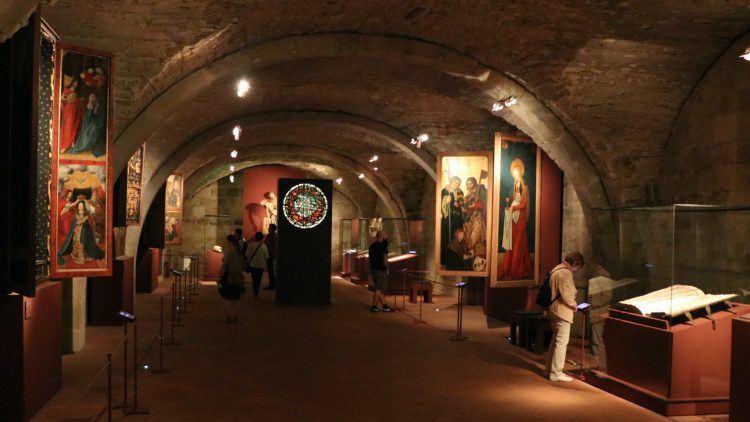
Opening Hours
The Naumburg Cathedral is open for tourist visits every day of the year. The opening hours are:
March to October:
- Monday to Saturday from 9:00 to 18:00
- Sunday and religious holidays from 11:00 to 18:00
November to February:
- Monday to Saturday from 10:00 to 16:00
- Sunday and religious holidays from 12:00 to 18:00
- 24 December — 9:00 to 12:00
- 31 December — 9:00 to 14:00
Allow at least an hour for a visit although following the audio guide around two hours are required (including the treasury).
A tower may be scaled on guided tours (€3) on Friday, Saturday, and Sunday at 15:00 from March to October. Minimum age is 6 years.
Ticket Prices
Admission tickets to the Naumburg Cathedral are €7.50 (€5.50 for students and €3 for school children) and include admission to the cathedral, treasury, garden, cloister, exhibition, and use of an audio guide.
Family tickets are €19 (two adults and own school-aged children).
A combination ticket with the Merseburg Kaiserdom is €13.
Transportation to Naumburg Cathedral
The entry to the Naumburger Dom is from the east of the church at Domplatz 16. Parking is available at the nearby “Unter dam Dom” parking lot — free street parking is available a few blocks away but only use if understanding German parking rules. The cathedral is to the far west of the town center (Markt) as a reminder that the church and secular rulers had separate towns back in the middle ages.
Naumburg an der Saale has very good railway links to other cities in Germany in the immediate region including Halle, Leipzig, and Jena — see German Railways timetables for travel planning to Naumburg (Saale) Hbf. Trains to Halle and Leipzig take around half an hour while Berlin may be reached in two hours — change trains in either Halle or Leipzig.
If using only local trains in the region, the Saxony-Anhalt Ticket is a great savings option. This Länderticket covers local train and bus transportation in all of Saxony-Anhalt, Saxony, and Thuringia, and has the same validity and price as the Sachsen or Thuringia Tickets.
It is around a 15-minute walk from Naumburg Bahnhof to the cathedral — it gets more interesting nearer the center. Taxis are a good option. The local bus is somewhat complicated and limited — walking may be faster.
Naumburg is a pleasant town of just over 30,000 inhabitants. It has several small hotels that get good Tripadvisor ratings and may be much better value than sleeping in one of the nearby cities.
Another top sight in Naumburg is the Stadtkirche St Wentzel with the fantastic organ built by Hildebrandt to the ideas of Bach and the guidance of Silberman. It was restored to its original condition and is often played. The church is on the Markt, which has several restaurants.
More photos of Naumburg Cathedral on Flickr.
